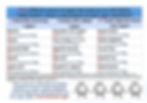
We are swimming in a sea of carbs. Too much is poisonous for our bodies.
Nov 20, 2024
3 min read
0
23
0
When I talk to clients about reducing carbohydrates, they often think of table sugar, chocolate, biscuits, ice cream, cakes and sugary drinks. This is true of course, but it is not the whole picture.
When people are diagnosed with diabetes, it means that their metabolism is struggling to cope with sugar. At that point, sugar becomes almost a poison. That is why it is so important to have the whole picture in order to either prevent or manage diabetes.
What are normal sugar levels?
If your blood sugar is normal, this means that you have 1 teaspoonful of sugar in your blood. The average person has about 5 litres of blood in their body.
The normal range for fasting blood glucose is 4.0-5.4 mmol/L (or 70-100 mg/dl).

(source: Dr Berg, Healthy keto and intermittent fasting)
As you can see, we hardly need any sugar. In fact, that teaspoon of sugar can come from a non-carb source such as protein. However, the average person in the UK and US consumes 31 teaspoons of sugar a day.

(source: Dr Berg, Healthy keto and intermittent fasting)
This means that your hormone called insulin has to work 31 times harder to remove all the sugar from your blood.
Where does this sugar load come from?
There are tools to help us understand how different carbohydrates affect blood sugar. The glycemic index (GI) and glycemic load (GL) measure different aspects of the same effect (blood sugar levels):
GI ranks foods based on how quickly they raise blood sugar.
GL adds a more precise angle by taking into account the GI + the size of a portion. This makes it less abstract.
In 2016, the Journal of Insulin Resistance published: "It is the glycaemic response to food, not the carbohydrate content of food, that matters in diabetes and obesity: The glycaemic index revisited".
The authors found that health professionals and patients struggled to visualise the GL in grams for a portion of food. This was because it was an unfamiliar term. People might also struggle to visualise a gram or kilocalorie of sugar, but are generally familiar with the quantity 'a teaspoon of sugar'. This is the approach they used to help us visualise the effects of different foods on our blood glucose levels.
When looking at basic foods, they considered 2 questions
How carby is a food?
How sugary is this particular carbohydrate?
The results show familiar foods with their glycaemic load expressed in teaspoons of table sugar:

The table shows is a very important variation between some common foods, with values ranging from 0.2 teaspoons of sugar for broccoli to a whopping 10.1 teaspoons of sugar for a portion of 150g of basmati rice.
The first question (How carby is it?) explains why a food like broccoli with a moderately high-GI of 54 has little actual effect on blood glucose. It is because the blood glucose response depends on the density of carbohydrates in the food and the amount of carbohydrates in broccoli is very low, the food being largely water. Therefore, for broccoli, the blood glucose response is very low, and almost independent of the food’s high-GI rating. However, for foods containing a lot of carbohydrates (e.g. ‘starchy’ foods), like the basmati rice, the blood glucose response strongly depends on the GI index. For the authors of the paper “it is these foods that have the potential for harm, particularly for those with obesity and diabetes.” If you want to see more details about the way they calculated the infographic, refer to the paper pages 2-4.
The paper also describes the amazing result Dr Unwin, a GP and his team from the Norwood surgery in Southport helping patients to cut out both sugar and starch. This simple step generated important benefits for the surgery’s patients with decreased obesity numbers and better diabetes control. There were also tangible benefits for the surgery itself in terms of cutting cost on diabetes drugs
The review concluded: “We recommend that dietary starch should be considered to be the equivalent of concentrated glucose; indeed, starches comprise condensed molecules of glucose. In the Norwood primary care practice, this knowledge helps general practitioners, health care professionals and patients to understand that starches are a significant source of blood glucose. Moreover, people generally eat equally as much, and often more, carbohydrate from starchy foods as from sugary foods and drinks; therefore, there should arguably be equal or more concern about the starchy foods we eat.”
In the table below, Dr Unwin has also summarised in a very accessible way the 3 main sources of sugar that make up our 'sugar load', expressed in 4g teaspoons of sugar equivalent.


